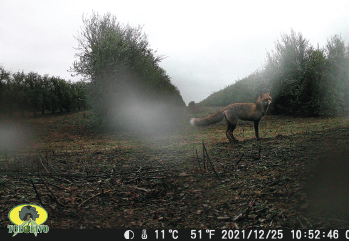The habitat created by this scrub forest is an attractive lure for countless animal species that find in it an ideal refuge to live.
The Encounter
We were strolling on an early autumn morning, riding in a 4×4 with the owners of ‘Villa del Río’ estate, conducting a routine technical visit to the Hedgerow Olive Grove planted 20 years ago on this property located in the Campiña Alta de Córdoba. The estate spans 161 hectares, with 61 hectares planted in hedgerow olive groves, while the remaining hundred hectares are traditional canopy olive orchards, which are prevalent in this region and extend across all neighboring municipalities.
Viewed from above, the hedgerow plantation resembles an aligned scrub forest, surrounded by a sea of canopy olive trees. From the highest part of the estate, looking north, the distant foothills of Sierra Morena can be seen. I remember being struck by the abundance of thrushes and rabbits that we saw everywhere as we ventured deeper into the labyrinthine rows of perfectly aligned hedgerows. With the windows rolled down, the repertoire of wild bird songs accompanied us like background music during our lively technical discussion as we leisurely drove along one of the service roads that traverse the estate from east to west.

During the visit, we were carefully inspecting the rows of olive trees and making pertinent observations about the trees’ condition, their fruit load, and the degree of ripeness as they approached imminent harvest. Suddenly, to everyone’s surprise, an impressive Iberian lynx emerged from one of the hedgerow lanes to our left.
It approached calmly, not speeding up upon seeing us nor altering its course, crossing right in front of us and stopping in the middle of the path. Durante unos segundos or a few seconds, the animal stood still, watching us attentively, with a poised posture, showing no hint of fear or concern, as if we were the intruders that it had caught trying to enter its forest domain. Moments later, it resumed its stride, as if nothing had happened, calmly disappearing into the hedgerow to our right and vanishing from our sight.

on the ‘Villa del Río’ estate (Córdoba).
We couldn’t believe what we had just seen an Iberian lynx in broad daylight, within a hedgerow olive grove. It seemed completely unheard of. Seeing our obvious surprise, the owners explained that this wasn’t the first time they had spotted the lynx on the estate. Their workers had also reported sightings, sometimes seeing what appeared to be a lynx with a cub from a distance. Additionally, they mentioned observing a wildcat prowling around, which they believed had impregnated one of their farm cats, evident from the kittens displaying inherited traits like their distinctive tails.
We asked if these feline sightings occurred elsewhere on the estate, and they confirmed that they were exclusively observed in the SHD Olive Grove, where a significant concentration of rabbits and other animals gathered. This revelation didn’t surprise us much; despite it being our first encounter with a lynx, during many technical visits to various hedgerow plantations, we had often noticed clear signs of abundant wildlife presence in these new olive forests, including red-legged partridges, thrushes, hares, rabbits, foxes, wild boars, and Spanish imperial eagles.
Initiation of the Study
This led us at Todolivo to reflect and question why these and many other animals chose the SHD Olive Grove as their preferred habitat for living and/or hunting. So, a few days later, we decided to dispel our doubts and contacted biologist Patricia Cosano Pérez (registration number 3469), whom we commissioned to conduct a study on the existing fauna in this Hedgerow Olive Grove plantation.

Methodology of the Study
To conduct the study and fauna sampling at the Villa del Río estate (Córdoba), the scientific method of linear transects has been chosen. This method involves establishing parallel sampling lines over the study area, which serve as reference for the technician to conduct animal counts during sampling, either at dawn or dusk, depending on the species under study.

Additionally, multiple automatic waiting cameras were strategically placed in different areas of the estate. These cameras are capable of recording and documenting animal movements at any time of day. Furthermore, analysis was conducted on both animal droppings and tracks found along the linear transects (sampling lines) located in the Hedgerow Olive Grove. These, along with the cameras, have proven invaluable in complementing this faunal study. The total distance covered by these linear transects in sampling was 9.262 kilometers.
Results
Following the meticulous sampling conducted by biologist Patricia Cosano in the 61 hectares that comprise the Hedgerow Olive Grove at Villa del Río estate, numerous animals have been documented, as detailed below:
Iberian Lynx

Regarding the Iberian lynx (Lynx pardinus), three individuals have been identified: one male (Figures 1 and 5), one female (Figure 2), and one cub (Figure 6). The reason these large predators come to hunt in the SHD Olive Grove and not other areas of the estate is due to the abundance of rabbits found there. It’s important to note that these small mammals constitute between 70% and 95% of the lynx’s diet base. each lynx consumes at least one rabbit per day to survive. In Figure 7, you can observe the hunting strategy employed by a pair of lynxes: they advance together along the same hedgerow row, each on a different side, to better stalk and surprise their prey.
Although these felines typically exhibit crepuscular habits, the multitude of photos captured by the camera traps reveal a broad and varied range of activity times on this estate. This indicates that their presence here is not accidental; rather, they have found an ideal habitat in this hedgerow forest where they can reproduce and find a substantial portion of their necessary food.

Rabbit
During the observation along the various transects of the SHD plantation, at least 123 rabbits were spotted. However, photos taken by strategically placed camera traps on the estate indicate that the actual population exceeds this number. One might wonder why there is a higher density of these small mammals in the hedgerow compared to other areas of the estate where their presence is much lower. The reason is simple: the arrangement of the olive trees in hedgerows allows them to form long rows of vegetation that closely resemble the shrubland found in the Mediterranean forest.

This provides rabbits with shelter and protection from their predators, hiding them from view and providing a quick escape route in case of danger. The presence of these animals in the SHD Olive Grove does not pose a problem for the plantation, as they do not cause damage to mature olive trees. However, they play a crucial role in the balance of this new Mediterranean forest ecosystem, as they are the basis of the food chain, enabling the existence of many other animals.

Fox

The common fox (Figure 10), although an omnivorous animal with a varied diet, relies primarily on rabbits in this estate to satisfy its daily nutritional needs. In the SHD Olive Grove, it finds an ideal place to hunt due to the existing animal biodiversity and the shrub forest that allows it not only to conceal itself when necessary but also to approach its prey unnoticed, thereby surprising them.
Wild Boar

Another species we have been able to find on the estate is the wild boar, which has only been observed through the cameras (Figure 11), as it tends to be predominantly nocturnal. The wild boar is omnivorous, and while its diet is primarily plant-based, it also supplements it with rodents, small rabbits, and invertebrates such as worms and insects.
Wildcat

The habitat of the wildcat (Figure 12) typically includes Mediterranean forests with abundant shrubbery and deciduous forests, although it is found throughout the Iberian Peninsula. hey are elusive animals that avoid human presence and have only been detected through camera traps, as they do not typically appear in broad daylight.
Through the cameras, images have captured several species whose presence was previously unknown on this estate, such as the Iberian ibex (Capra pyrenaica), the mongoose (Herpestes ichneumon), and the European badger (Meles meles).
Mongoose

This mammal (Figure 13) is the only species of mongoose in Europe. It is one of the few diurnal carnivores, utilizing daylight to hunt and avoid its main predators like foxes and lynxes. Its diet primarily consists of rabbits, rodents, reptiles, small birds, and insects.
European badger

As for the European badger (Figure 14), belonging to the Mustelidae family, this robust mammal with short legs is omnivorous.
It feeds on small rodents, rabbits, earthworms, insects, roots, fruits, and herbaceous crops. It is nocturnal, typically beginning its activities at dusk.
Iberian ibex

Images have captured an Iberian ibex (Figure 15) in the center of the estate, although it was only seen on one occasion, suggesting it may have been passing through.
Common blackbird

This migratory bird (Figure 16) is omnivorous, feeding on invertebrates, olives, and seeds. It typically arrives in Spain in late August and remains until March,
migrating back to Central and Northern Europe (England, Germany, and Scandinavia). Its preferred winter habitat includes olive groves and shrublands of lowlands and hillsides, making it particularly attracted to this new SHD Olive Grove.
Iberian magpie

This small corvid with a long blue tail is omnivorous. It is highly gregarious, forming groups of varying sizes, and tends to be sedentary, rarely leaving its territory once established. From our observations, it finds this new Mediterranean shrub forest an ideal place to live.
Conclusion
The SHD Olive Grove represents a new form of Mediterranean shrub forest that fosters a rich diversity of animal life. Wherever it is established, it serves as an attractive and stable habitat for numerous animals seeking refuge, food, and reproduction opportunities.

Note: For rabbits, the graph reflects sightings along linear transects,
but based on photos and fecal findings,
their population is estimated to be higher.
Furthermore, the evolution in which we currently work, known as the ‘Todolivo Hedgerow Olive Grove® broad framework system,’
contributes to improving the sustainability of the planet. It boasts a highly positive Carbon Footprint balance (around 2,900 kg CO2/ha/year) and requires less consumption of inputs and natural resources.



